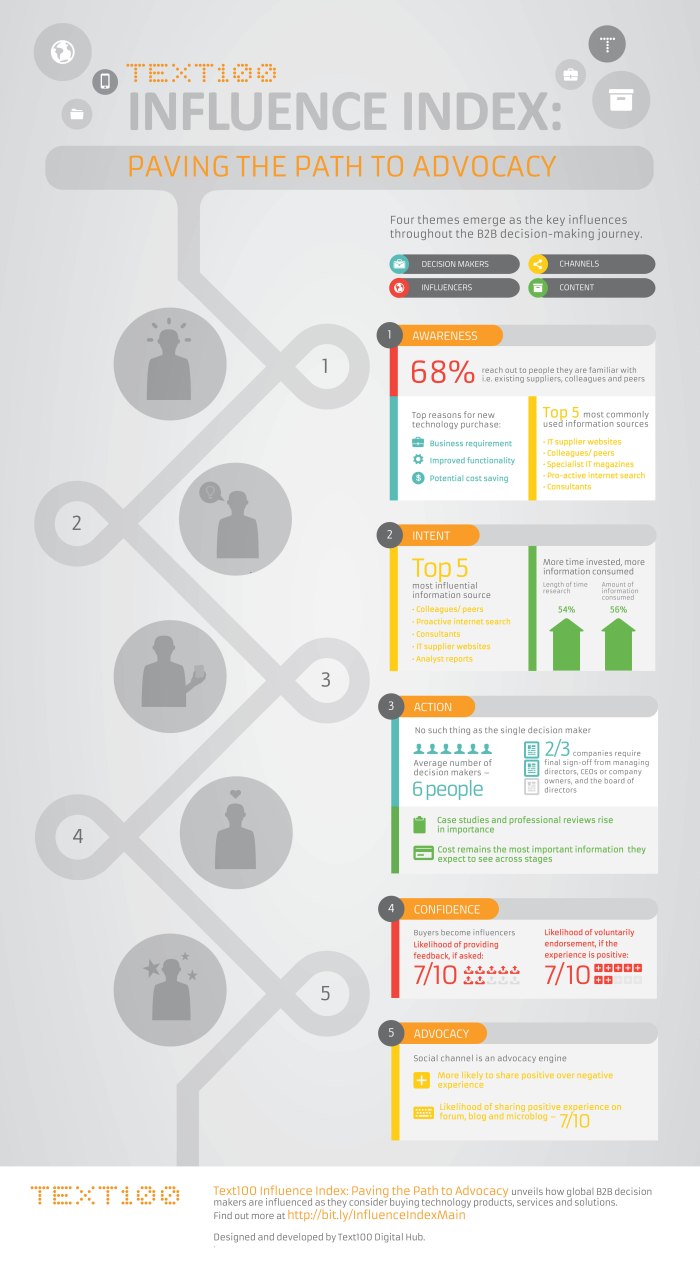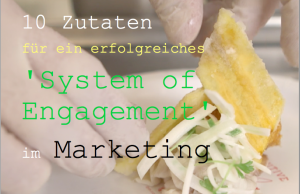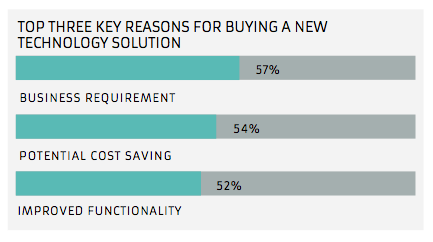OR
From Mass Marketing to ‘Systems of Engagement’ (with special Focus on B2B)
This article is based on a presentation I gave end May at the DNUG Conference.
It is no longer possible to ignore the fact that there has been a dramatic change in the way people buy products today due to the Internet, the social web and the wide range of mobile devices with which everyone is always connected. Customers can use the Internet not just to get information about products, but also to see what other people say about a product or a service, both the positive and the negative opinions. It is true that customers have always listened to the recommendations of friends and acquaintances: this restaurant is good, that holiday hotel is great.
But while in the past, customers got such recommendations by talking to other people, today they are passed on through the social web on TripAdvisor, Facebook or in other networks and channels.
Customers today are in a much better position to get better and more in-depth information before they buy a product. And that is what they do, not just as consumers. According to Google and CEB, around 60% of the traditional sales process in B2B sales has simply disappeared. Analysts such as Forrester think that buyers have completed 90% of their decision-making process before they even get in touch with the vendor. And then it is often only a matter of negotiating the price.
This should make people involved in sales and marketing think long and hard and overhaul their strategies. The trend clearly seems to be moving away from traditional mass marketing to a more targeted, personalized and personal customer approach. Instead of reaching out to customers using the old megaphone approach with promotional letters, mass emails, telesales and, more recently, trite promotional messages via Facebook and Twitter, marketers now have to stop and think about how to best approach their customers in future.
The latest research shows that customers are tired of receiving dull, irrelevant promotional messages addressed to everyone and no one in particular. What’s more, data protection regulations are getting tighter. In Germany a company may only send e-mails and e-mail newsletters to customers who actively register for them. And many mailings are picked up by the SPAM filter or are manually put in the trash can (either the digital or the real one in the case of letters sent by post). There are more restrictions on calls from telemarketing agencies too. Germany has become a country where the customer has to explicitly “opt-in.”
Let me make one thing clear: I am not opposed to traditional marketing and certainly believe that mailings, e-mail newsletters and, where applicable, TV commercials and print ads and “real” events still have their place and can make sense. They are still part of a sound marketing mix. But this marketing mix has to be adapted to the demands of the 21st century. We are moving away from the mass-marketing approach, towards direct engagement with customers. Geoffrey Moore has coined the term “systems of engagement” for systems that directly affect people and give them added value. The German word “engagement” also has a positive association, meaning commitment, in this case to the customer, and this is where we need to head in marketing. Other people talk in terms of “outbound” and “inbound” marketing.
Marketers now need to focus on delivering the right information and incentives to the customer at the right time and the right point in their decision-making process. And that is definitely easier said than done. However, a range of surveys and studies are available that analyze which information and contacts the buyer uses at what point. Text100 recently surveyed around 1,900 people on how they make their B2B technology decisions. The results were put into a matrix showing which mechanisms and information are used the most and have the most influence at which point in the decision-making process.
Here are my 10 ingredients for creating an attractive “system of engagement”:
(1) Integrate your company’s owned, paid, earned and social channels
The concept of paid, owned, earned and social channels is no longer new. You have your own sources of information – the classic one here is your own website – you pay for advertisements or advertorials, you hope to earn positive feedback on products, and social channels are having an even increasing impact on decisions. The trick is to make sure that all these aspects of marketing fit together so that, ideally, they complement each other. Every marketing campaign today should include a checklist of what to do, when, and in which area, in order for it to be successful. This should go without saying but, in my experience, it doesn’t.
(2) Make your website THE focus of content, interaction and engagement
A few years ago, the question of whether companies actually still need to have their own website was hotly debated. Surely it could all just be put on Facebook. That’s hokum though: you cannot and should not rely on an external platform. A company needs to have its own website that it actually owns. Of course, this website will not be the same as it was ten years ago. It’s no longer about having a high-gloss brochure online but a platform where customers can find all the information they need without filling out endless registration forms for a download. The website must be continuously analyzed and optimized. It is no longer acceptable for several months to pass before a relaunch project is completed and a new website is rolled out. And, of course, it should be really easy for customers to get in touch with the company.
(3) Content is king – supply your customers with content that is of interest to them
“Content marketing” is a term that every marketer should be familiar with by now. That said, it’s surprising how little high-quality content is actually provided most of the time. But white papers, reference reports and videos are just not as easy to produce as mass mailings. Of course, these types of content should not just be found on the company’s own website, but also elsewhere in order to attract more attention. The IBM expert pages in the magazine Computerwoche, for example, try to combine independent, editorial articles with high-quality content and the expert knowledge of IBM, presented in many different forms including videos, surveys and live chats. The focus here is on content and expertise and not bland advertising.
(4) Tell interesting real-life stories
The expression “he’s telling tales” has a distinctly negative connotation, but actually, nothing works like a good story. And they certainly don’t have to be made up. True-to-life stories are an excellent way of relating content in an entertaining and authentic manner and an art which is unfortunately not very widespread in the IT industry or in Germany in general. I think the new “Made with IBM” campaign is exactly the right way to go. Customers, partners and IBM staff tell their stories of how they solved a particular problem and the advantages it brought them. But a 30-second video is not going to cut the mustard here. You have to add meat to the stories in the way of content. Ideally this kind of concept will then go viral, become internalized by the entire system and be used and distributed via websites, communities and social channels.
(5) Offer your customers the most personalized experience possible and understand your customers
The call for marketing to take a more personalized and personal approach has been around for some time. But “personalized” does not just mean addressing the recipient by name, it’s about addressing their particular needs and interests. This may be difficult to do if you don’t have a full customer profile. For example, you may have the report on the visit to a trade show but you don’t know exactly what they have researched on the website and what other information they already have. That’s why IBM has acquired the behavioral marketing expert Silverpop that provides personalized customer engagements in highly scalable environments via the various channels. These solutions gather Big Data, often analyzed in real-time, which is then used by marketing automation tools to supply customers with the content relevant to then.
(6) Understand and track your social business network
Business networks have always played a major role, in the offline world, too. The social web has dramatically increased the power of business networks, making it extremely important for companies to understand the social networks and relationships relevant to their company and their customers. Business partners, competitors, influencers, customers, prospective customers, organizations and associations, your own company and customers are all interacting with one another. From a marketing perspective, this means that you should keep track of the online options available and identify the most relevant sites and communities in which you need to feature.
(7) Find out who has most influence on your customers
In the analysis of the network mentioned above, another important aspect is to identify the top influencers of a particular sector or industry. These are no longer only journalists, traditional consultants and analysts. Many other people and groups have become more influential through the social web. Increasingly, influencers are other customers, bloggers and active community managers. A company needs to identify these people and establish a relationship with them. That’s why I prefer to talk about “influencer relations” rather than “influencer marketing”. What makes these influencers so important?
(8) Understand the influence (and the risks) of recommendations
Where customers are concerned, negative recommendations have at least as much impact as positive ones on purchasing decisions. According to Nielsen, 79% of people in the US trust the recommendations of personal acquaintances and around 50% trust reviews that are placed online. Based on its survey, Text100 says that recommendations from the prospective buyer’s direct area of influence can make or break a purchasing decision. So companies need to provide the influencers with the right key information. This is why clever companies treat influencers with the same attention and care as they do journalists and analysts. Of course, this also opens up room for abuse, with companies trying to buy themselves recommendations or dubious customers threatening companies with bad online reviews.
(9) Encourage your customers to be active
It may be stating the obvious, but it can’t be repeated often enough: nothing beats a satisfied customer. Customer satisfaction surveys and initiatives topped the agenda of every vendor for a long time. I’m not sure this is still the case. So it’s time to refocus: Customers who are satisfied are generally happy to tell other prospective buyers about their positive experience. And, according to the Text100 survey, they often do so on their own initiative, without the company even being aware of it. In my opinion, user groups are among the most effective multipliers. Sure, they can put pressure on a company if they are not happy, but if they are, then they are the best multipliers. So here’s the rule: satisfy your customers first, and then approach them about reference reports and quotes and integrate them in communities. Satisfied customers are the best extended sales arm of your company.
(10) Activate your employees by making sure they are all “social”
But top of the list, even before your customers, are your own employees: you should make sure they are your company’s active and positive advocates. That sounds normal. And it certainly used to be normal, but according to employee (non-)satisfaction surveys, that’s no longer the case. Satisfied, motivated staff are key to the success of every company. If you then motivate and reward them for actively being a brand ambassador out in the big wide world, then you will increase the reach and credibility of your company enormously. The sales staff should be integrated in social channels such as LinkedIn or Xing, and the technical staff need to blog and be involved in communities. R&D staff should apply feedback from customers to product development. HR staff can identify the much talked about “high potentials.” And so on. Of course not everyone is equally suited to being a brand ambassador in the same way but, in principle, they can all contribute.
Marketing in the 21st century, the “social era”, has definitely not got any easier. The traditional channels and measures are still relevant, but the digital and social channels need to be added to the marketing portfolio. The Internet and the social web have radically changed the sales process. Prospective buyers get their information from the web, not by visiting trade shows or events as they did in the past. And they don’t just get information, they also get opinions. This makes it essential for companies to be active on the web. By active I mean listening on the one hand, and being visible and present on the other, providing valuable information from their own experts, in communities or through positive customer statements. The one thing to remember is that the relation to the customer is paramount. The companies that flourish are the ones that listen to their customers properly, online and offline, that take care of them and are dedicated to them.
Filed under: English Tagged: CMO, Digital Marketing, featured, Marketing, SocBiz, Social Media










